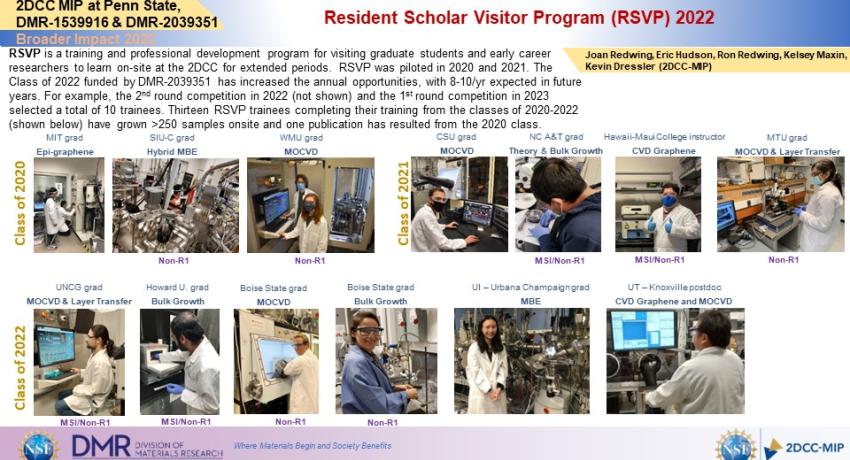RSVP is a training and professional development program for visiting graduate students and early career researchers to learn on-site at the 2DCC for extended periods. RSVP was piloted in 2020 and 2021. The Class of 2022 funded by DMR-2039351 has increased the annual opportunities, with 8-10/yr expected in future years. For example, the 2nd round competition in 2022 (not shown) and the 1st round competition in 2023 selected a total of 10 trainees. Thirteen RSVP trainees completing their training from the classes of 2020-2022 (shown below) have grown >250 samples onsite and one publication has resulted from the 2020 class.
What Has Been Achieved: The 2DCC launched a new “Resident Scholar Visitor Program (RSVP)” in 2020 to host research experiences at the 2DCC for grad students and early career researchers. The goal of the RSVP program is to provide a 2-6 month, in-person training and on-site research experience focused on the synthesis and characterization of 2D materials. The program has grown from 3 participants in the inaugural year of 2020 to 8-10 participants per year going forward. The participants receive hands-on training in all areas of 2DCC including Theory. Since 2020, thirteen completed experiences included trainee growth of more than 250 samples.
Importance of the Achievement: Training the next generation crystal growers and theorists is critical to the 2DCC platform and the competitiveness of the U.S. in next generation semiconductor technologies.
Unique Feature(s) of the MIP that Enabled this Achievement: 2DCC’s combined platform focus on both knowledge sharing and materials discovery applied to training the next generation of growers and theorists and layered with state-of-the-art facilities creates an environment for robust onsite learning opportunities and collaboration. This approach is the impetus for fueling new lines of collaborative research. Knowledge sharing among users and trainees enabled a joint external user RSVP publication in MBE synthesis shown below.
Publication: Aofeng Bai, Maria Hilse, Prasanna D. Patil (RSVP trainee, Non-R1), Roman Engel-Herbert, Frank Peiris (external user, Non-R1) Journal of Crystal Growth 591, 126714 (2022); DOI: 10.1016/j.jcrysgro.2022.126714
Acknowledgements: The work at Kenyon College was supported by the NSF grant DMR-2004812. This work at The Pennsylvania State University was facilitated by the Two-Dimensional Crystal Consortium – Materials Innovation Platform (2DCC-MIP) at The Pennsylvania State University, which is supported by NSF cooperative Agreement No. DMR-2039351. P.D.P. acknowledges the support provided by the Graduate School, Southern Illinois University Carbondale, through the Doctoral Fellowship and 2DCC-MIP, the Pennsylvania State University through Resident Scholar Visitor Program (RSVP).
